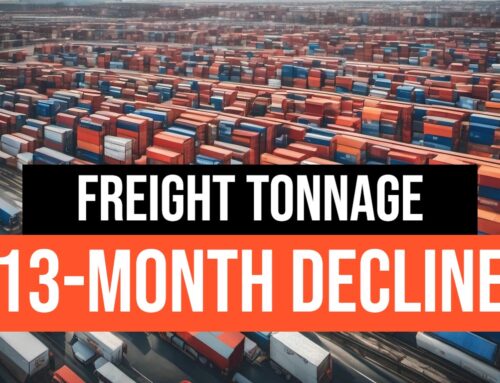Table of Contents
The trucking industry has been hit hard by one of the longest and deepest freight recessions in recent memory. This freight recession has been more severe than the downturn caused by COVID-19 and surpassed the short bull market that followed.
The roots of this downturn can be traced back to imbalances that built up during the pandemic. When lockdowns ended and supply chains reopened, there was a surge of pent-up consumer demand that overwhelmed shipping capacity. This led to a period of extremely high freight rates and struggles to find available trucks. However, as consumer spending cooled off in response to inflation and interest rate hikes, freight volumes plummeted leaving too many trucks chasing too little freight.
FreightWaves Predicted the Freight Recession
Back in March 2022, the freight forecasting company FreightWaves predicted that a freight recession was on the horizon. Now, over a year later, they are finally seeing signs that a recovery may be starting.
Signs of an Emerging Recovery

While the freight recession has been long and difficult, there are several data points and forecasts that suggest the industry may finally be turning a corner toward recovery. Leading indicators of freight demand and supply are starting to show improving conditions after an extended downturn.
By analyzing various market metrics and economic projections, we can see evidence that the supply and demand imbalance that caused this recession is slowly but surely correcting itself. As demand increases from economic growth while trucking capacity contracts, the stage is being set for a rebound in freight volumes and rates.
1. Outbound Tender Rejection Index Improving
One positive sign is the Outbound Tender Rejection Index, which measures relative trucking demand. This index has shown year-over-year market condition improvement recently. The Outbound Tender Rejection Index tracks the percentage of contracted freight tenders that are turned down by carriers. When this percentage declines, it signals increasing demand as carriers are able to accept more contracted freight loads.
After peaking at around 25% in early 2022 during the height of the supply-demand imbalance, the index has gradually decreased to around 6% currently. This return to levels more typically seen during balanced market conditions is an encouraging indicator that freight demand is starting to recover. While still elevated compared to pre-pandemic levels below 5%, the index’s downward trajectory over the past year aligns with other emerging signs of the freight recession’s decline.
2. Contracted Load Volumes Increasing
Additionally, contracted load volumes are up 9% compared to the same time last year according to FreightWaves’ data. This signals that demand for trucking services is starting to rebound. Contracted load volumes refer to the number of freight loads being hauled under pre-arranged contracts between shippers and carriers.
This 9% year-over-year increase indicates that shippers are needing to move more goods via truck transportation as economic activity picks up. During the depths of the recession, many shippers pared back their contracted freight volumes due to slowing sales and supply chain disruptions. As consumer demand improves and supply chains normalize, those shippers are now booking more contracted trucking capacity again.
The rise in contracted volumes shows that not only are more total trucks needed compared to 2022 lows, but carriers with dedicated contracted loads are seeing a resurgence in their primary revenue stream. This solidified demand from shippers is a reassuring sign for carriers as the market transitions out of the recession.
3. The Market Gradually Balancing
While freight volumes are still well below the peak levels seen before the recession, the market does appear to be gradually balancing between supply and demand. Despite the gap from those peak volumes, a better equilibrium is returning. Industry analysts estimate that overall truck freight volumes remain around 15-20% below the historic highs reached in late 2021 before the downturn began.
However, the pace of volume declines has slowed substantially over the past 6 months. Simultaneously, trucking capacity has been leaving the market as financial pressures force some carriers to downsize or close up shop entirely. This gradual tightening of supply and demand is leading to a long-awaited better balance after over a year of excessive imbalance.
Freight rates, which plunged during the recession, have started to level off and even inch higher on some major routes as capacity loosens its grip. While the imbalance hasn’t fully corrected yet, these indicators show the market slowly calibrating back towards an equilibrium between available trucks and freight demand. Analysts expect this balancing act to continue playing out through 2024 as the recovery takes hold.
4. Economic Growth Could Mean More Freight Demand
Looking ahead, the Atlanta Federal Reserve’s GDP forecasts predict around 3% year-over-year economic growth. If this holds true, it would likely lead to increased freight demand as more goods are shipped across the country. GDP growth is closely correlated with freight transportation activity, as greater economic output generally means more raw materials, components, and finished goods need to be trucked from suppliers to manufacturers to retailers.
The 3% GDP growth projection from the influential Atlanta Fed follows a stagnant 2022 where the economy teetered on the brink of recession amid high inflation and aggressive interest rate hikes by the Federal Reserve. While modest, the 3% growth rate would mark a return to healthy economic expansion after a prolonged period of volatility and slowdown.
For the trucking industry, steady GDP growth supports higher freight volumes as increased consumer spending and manufacturing activity flows through supply chains. Historical data suggests that every 1% increase in real GDP correlates to a 1-1.5% rise in truck freight volumes. So if the 3% GDP forecast proves accurate, truckers could see freight demand increase by 3-4.5% year-over-year as the recovery takes root.
5. Declining Capacity Helping Rebalance Market
On the supply side, trucking capacity in the market has been declining since late 2022 according to industry data. This reducing supply should help rebalance the market as freight demand picks up from economic growth. After rapidly expanding during the pandemic boom years, the number of available trucks and drivers has started contracting over the past 12-18 months.
According to estimates from the American Trucking Associations (ATA), the total tractor-trailer truck fleet shrank by around 3% in 2022 and may contract another 1-2% in 2023 as smaller carriers face bankruptcy and larger fleets downsize. Driver shortages have also plagued the industry, with estimates of 80,000+ unfilled driver positions currently.
This decline in trucking capacity comes after years of excessive expansion that outpaced freight demand growth. The capacity glut made the 2022-23 recession particularly brutal for carriers stuck with too many trucks and not enough freight. As capacity pulls back closer to demand levels, trucking companies still operating stand to benefit from higher freight rates and volumes as supply and demand rebalances.
The dual impacts of shrinking capacity and forecasted economic growth bode well for a trucking recovery to take hold through 2024 and into 2025. A righter-sized fleet and driver pool paired with rising freight movement signals the stage is set for market equilibrium to be restored.
Potential Recovery Timeline
 While the emerging data signals the freight recession may be nearing an inflection point, the trucking industry has undoubtedly been through a brutal downturn. Companies have had to endure an extended period of financial stress and losses as the market imbalance weighed on revenues.
While the emerging data signals the freight recession may be nearing an inflection point, the trucking industry has undoubtedly been through a brutal downturn. Companies have had to endure an extended period of financial stress and losses as the market imbalance weighed on revenues.
Navigating the choppy waters of this recession cycle has tested the resilience and business fundamentals of trucking fleets across the nation. However, those that have managed to stay afloat through the worst of it may soon start seeing their perseverance pay off as conditions improve in the coming months.
Looking at the trajectory of key indicators like the Outbound Tender Rejection Index and GDP forecasts, industry analysts have mapped out potential recovery timelines. Their projections lay out when truckers could expect to experience meaningful freight volume and rate increases ushering in a new period of profitability.
Operating at a Loss for a Long Time
Unfortunately, many trucking fleets have been operating at a loss for a long period during this downturn. The extended recession has strained finances across the industry. According to data from transportation analytics firm FreightWaves, around 60% of trucking companies were upside down and losing money by the end of 2022.
The combination of plunging freight rates and volumes alongside elevated operating costs like fuel and insurance premiums created a cash flow crunch. Spot market rates fell over 40% in some freight corridors compared to 2021 highs, while contract rates lagged in adjusting downward. At the same time, diesel prices spiked over $5 per gallon.
Smaller fleets and independent owner-operators were among the hardest hit without the capital reserves of their larger counterparts. Numerous bankruptcies and companies getting out of trucking exacerbated the capacity reductions. Those able to hold on faced taking out loans, deferring equipment upgrades and maintenance, and making difficult workforce cuts just to survive.
While signs now point to potentially brighter days ahead, the scars of this prolonged downturn will take time to fully heal for an industry that has endured tremendous financial strain. Rebuilding profitability and paying down accumulated debt overhangs remain major challenges even as the recovery takes root.
Recovery Expected by 2025
However, based on the emerging trends of falling capacity and rising demand, industry experts believe we could see a recovery start taking hold by fall 2024. A more certain and full recovery is projected by spring 2025 if these conditions continue improving at the current pace. Forecasting firms like FTR Transportation Intelligence are eyeing the second half of 2024 as an inflection point when trucking markets could shift back into growth mode.
The expected economic expansion driving freight demand higher is projected to intersect with an anticipated trucking capacity crunch by late 2024, as supply has now contracted too far. This supply-demand rebalancing should allow carriers to finally regain their negotiating leverage over shippers and raise rates after years of stagnation.
But analysts caution that 2024 could still be a transitional year of just modest growth before a full-fledged recovery takes firmer hold in 2025. Most baseline industry forecasts show freight volumes not fully regaining 2022 levels until after the spring of 2025 as the supply chain catching up with pent-up demand.
The depth of the hole created by this recession cycle means its recovery trajectory may prove more elongated than typical shorter downturns of the past. Still, light appears at the end of the tunnel brightening prospects for truckers who can make it through the intervening months.
Looking Ahead to Recovering Freight Levels
In summary, after an extended freight recession, there are increasing signs that the market may finally be starting to rebalance itself between supply and demand for trucking services. Truckers and fleets that can persevere through the rest of 2024 could be well-positioned when the recovery becomes more established in 2025 and freight volumes return to healthier levels.
While the road ahead still has potential potholes, sticking to disciplined business practices and cost management should allow surviving carriers to capitalize on rapidly tightening markets over the next 12-18 months. Reinvesting in equipment, hiring quality drivers, and securing dedicated freight contracts will be critical focus areas.
Those who weathered the storm and maintained their operational capabilities stand to benefit tremendously from increased pricing power as capacity maxes out amid rising shipments. After years of bearing the brunt of an oversupplied market, truckers finally have light at the end of the tunnel to a realigned landscape more tilted in their favor.
The freight recession proved harsh but could potentially restore some equilibrium and profitability to an industry that overheated during the pandemic. Haulers positioning themselves wisely may be poised to thrive again as supply chains regain their footing and economic growth propels freight demand forward in the coming recovery cycle.
Beat the Freight Recession with AFT Dispatch
Want to take your trucking business to new heights? AFT Dispatch has the solutions you need. Simply complete the short form on this page, and we’ll reach out with details on how our services can boost your profits and efficiency. Prefer to discuss your needs directly? Give us a call or send a text anytime to (801) 448-6363. Our knowledgeable team is ready to consult with you one-on-one.
As an owner-operator, continuing education is key to staying ahead of the competition. That’s why AFT Dispatch provides an entire library of free trucking videos covering a wide range of topics – from industry best practices to insider tips and tricks. Whether you’re a veteran hauler or just starting out, these resources will help elevate your skills and business acumen. Check them out today!






Leave A Comment